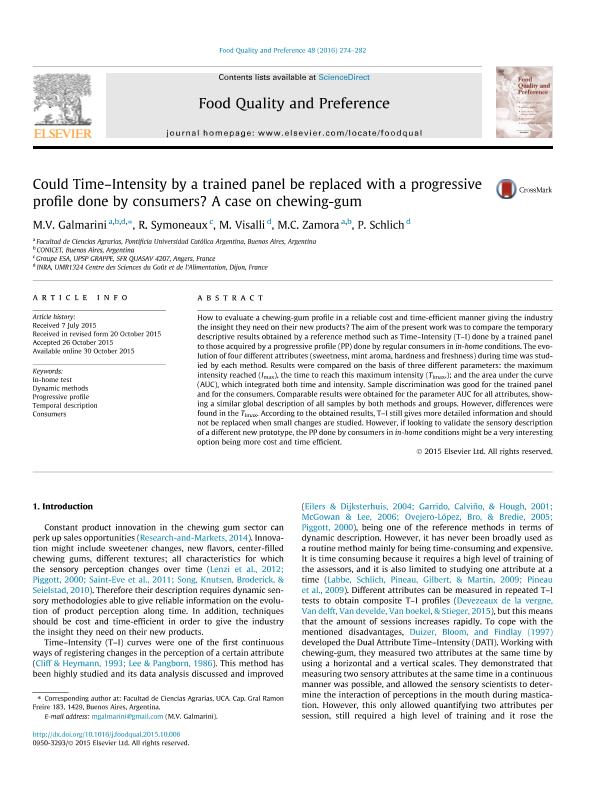Mostrar el registro sencillo del ítem
dc.contributor.author
Galmarini, Mara Virginia

dc.contributor.author
Symoneaux, R.
dc.contributor.author
Visalli, M.
dc.contributor.author
Zamora, María Clara

dc.contributor.author
Schlich, P.
dc.date.available
2018-05-03T17:18:42Z
dc.date.issued
2016-03
dc.identifier.citation
Galmarini, Mara Virginia; Symoneaux, R.; Visalli, M.; Zamora, María Clara; Schlich, P.; Could Time–Intensity by a trained panel be replaced with a progressive profile done by consumers? A case on chewing-gum; Elsevier; Food Quality and Preference; 48; 3-2016; 274-282
dc.identifier.issn
0950-3293
dc.identifier.uri
http://hdl.handle.net/11336/43985
dc.description.abstract
How to evaluate a chewing-gum profile in a reliable cost and time-efficient manner giving the industry the insight they need on their new products? The aim of the present work was to compare the temporary descriptive results obtained by a reference method such as Time?Intensity (T?I) done by a trained panel to those acquired by a progressive profile (PP) done by regular consumers in in-home conditions. The evolution of four different attributes (sweetness, mint aroma, hardness and freshness) during time was studied by each method. Results were compared on the basis of three different parameters: the maximum intensity reached (Imax), the time to reach this maximum intensity (TImax,); and the area under the curve (AUC), which integrated both time and intensity. Sample discrimination was good for the trained panel and for the consumers. Comparable results were obtained for the parameter AUC for all attributes, showing a similar global description of all samples by both methods and groups. However, differences were found in the TImax. According to the obtained results, T?I still gives more detailed information and should not be replaced when small changes are studied. However, if looking to validate the sensory description of a different new prototype, the PP done by consumers in in-home conditions might be a very interesting option being more cost and time efficient.
dc.format
application/pdf
dc.language.iso
eng
dc.publisher
Elsevier

dc.rights
info:eu-repo/semantics/openAccess
dc.rights.uri
https://creativecommons.org/licenses/by-nc-sa/2.5/ar/
dc.subject
In-Home
dc.subject
Dynamic Methods
dc.subject
Progressive Profile
dc.subject
Temporal Description
dc.subject
Consumers
dc.subject.classification
Alimentos y Bebidas

dc.subject.classification
Otras Ingenierías y Tecnologías

dc.subject.classification
INGENIERÍAS Y TECNOLOGÍAS

dc.title
Could Time–Intensity by a trained panel be replaced with a progressive profile done by consumers? A case on chewing-gum
dc.type
info:eu-repo/semantics/article
dc.type
info:ar-repo/semantics/artículo
dc.type
info:eu-repo/semantics/publishedVersion
dc.date.updated
2018-05-03T13:59:45Z
dc.journal.volume
48
dc.journal.pagination
274-282
dc.journal.pais
Países Bajos

dc.journal.ciudad
Amsterdam
dc.description.fil
Fil: Galmarini, Mara Virginia. Consejo Nacional de Investigaciones Científicas y Técnicas; Argentina. Pontificia Universidad Católica Argentina "Santa María de los Buenos Aires"; Argentina. Institut National de la Recherche Agronomique; Francia
dc.description.fil
Fil: Symoneaux, R.. Groupe ESA; Francia
dc.description.fil
Fil: Visalli, M.. Institut National de la Recherche Agronomique; Francia
dc.description.fil
Fil: Zamora, María Clara. Consejo Nacional de Investigaciones Científicas y Técnicas; Argentina. Pontificia Universidad Católica Argentina "Santa María de los Buenos Aires"; Argentina
dc.description.fil
Fil: Schlich, P.. Institut National de la Recherche Agronomique; Francia
dc.journal.title
Food Quality and Preference

dc.relation.alternativeid
info:eu-repo/semantics/altIdentifier/doi/https://dx.doi.org/10.1016/j.foodqual.2015.10.006
dc.relation.alternativeid
info:eu-repo/semantics/altIdentifier/url/https://www.sciencedirect.com/science/article/pii/S0950329315002621
Archivos asociados
